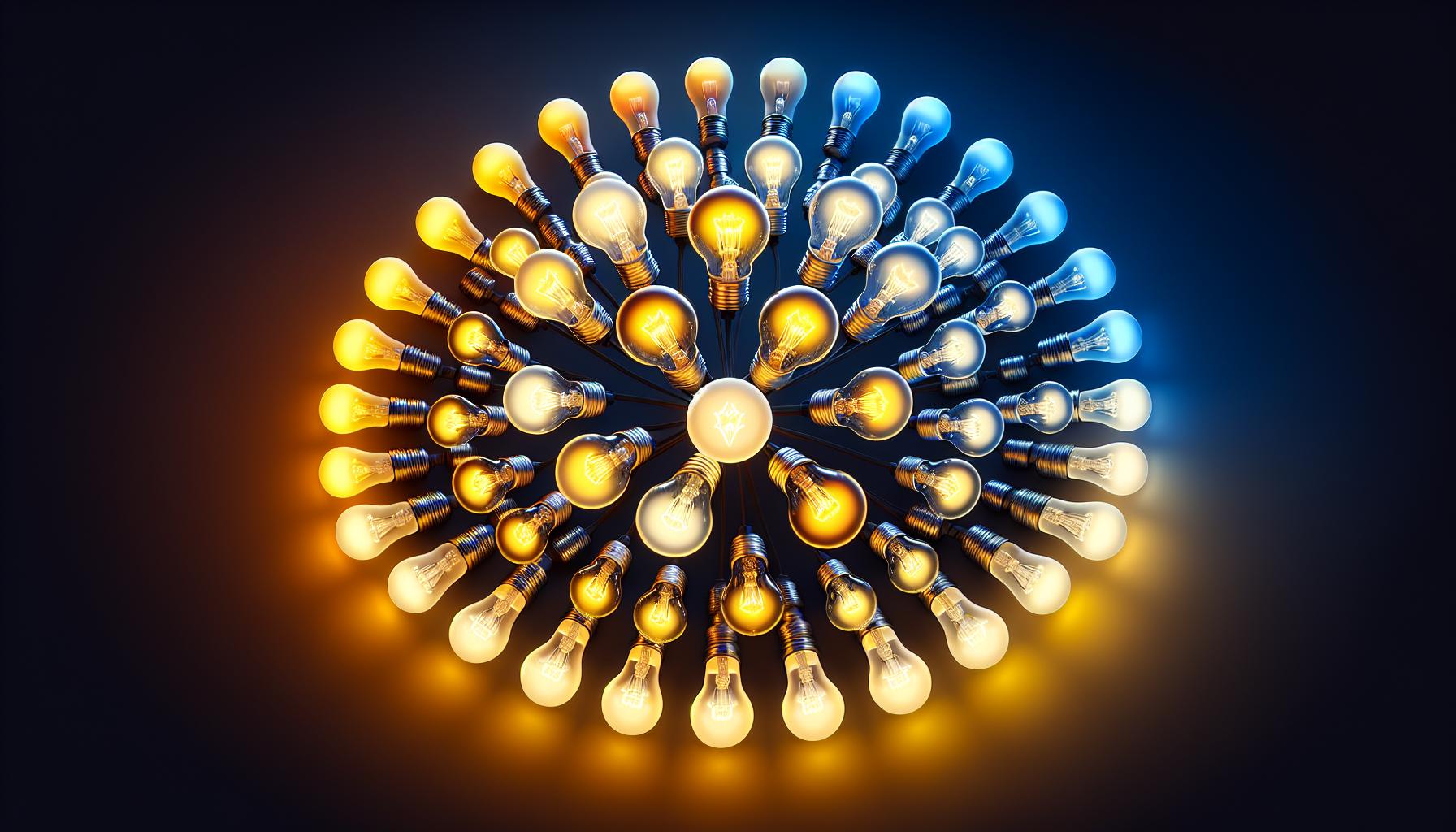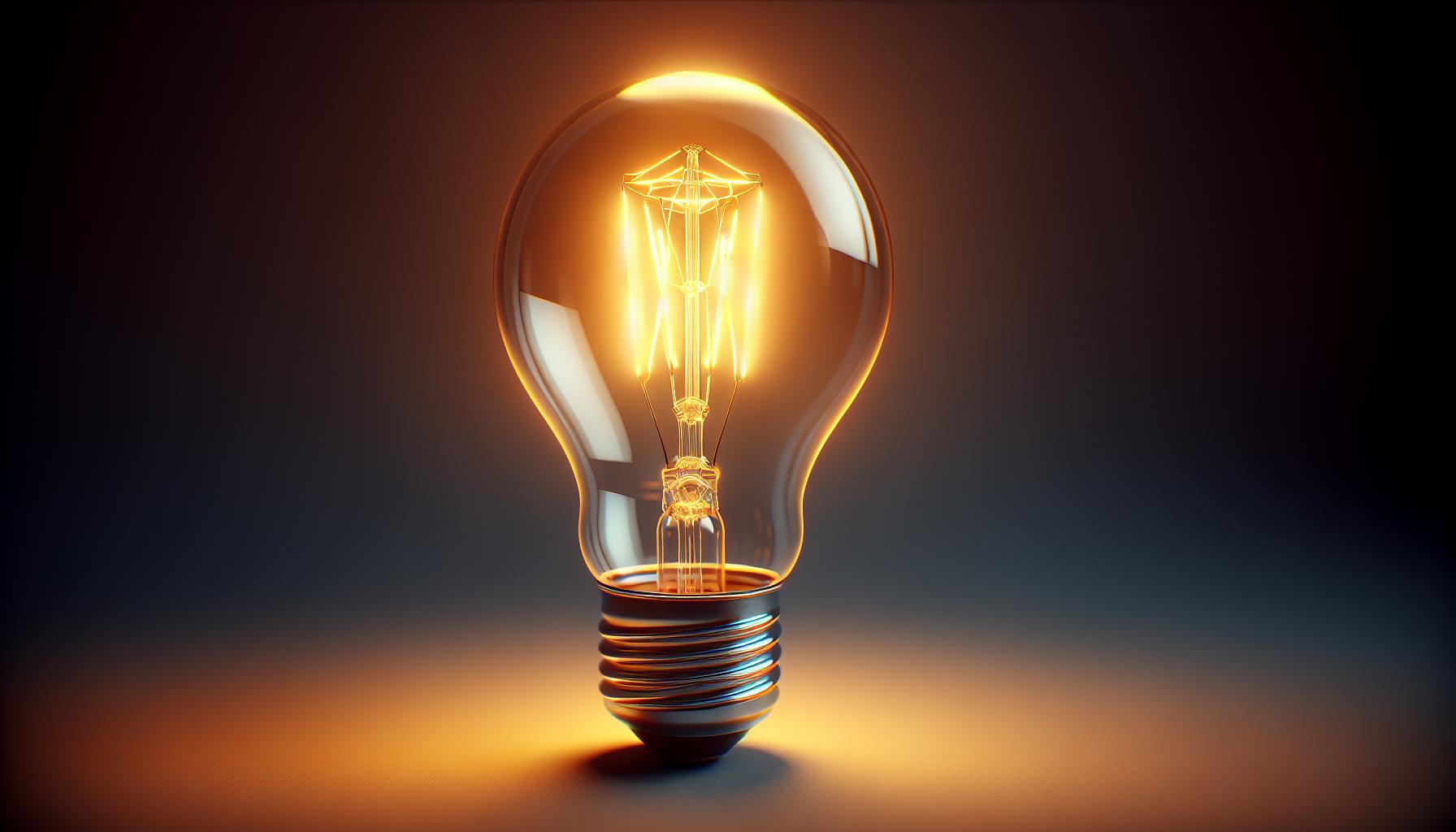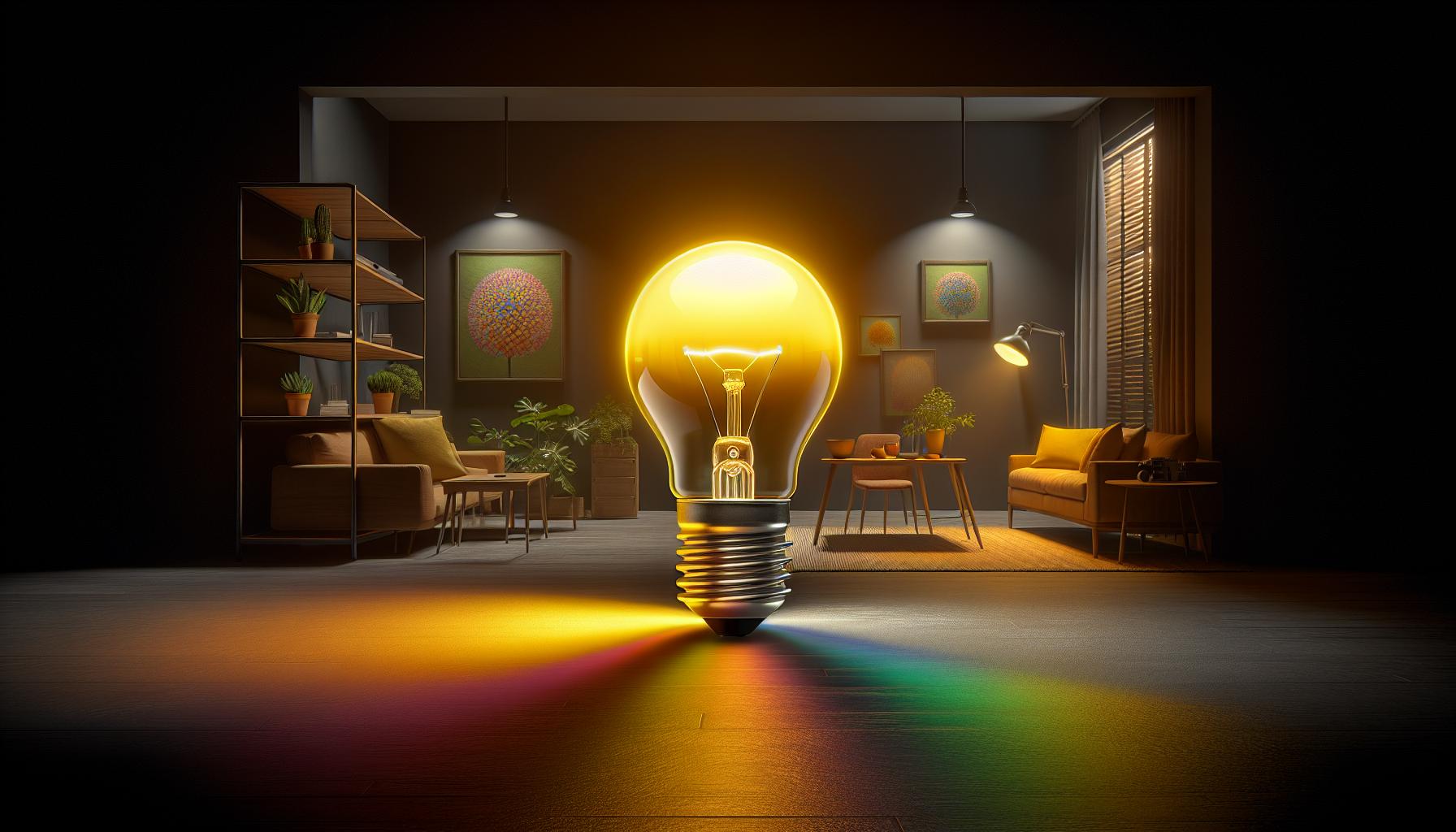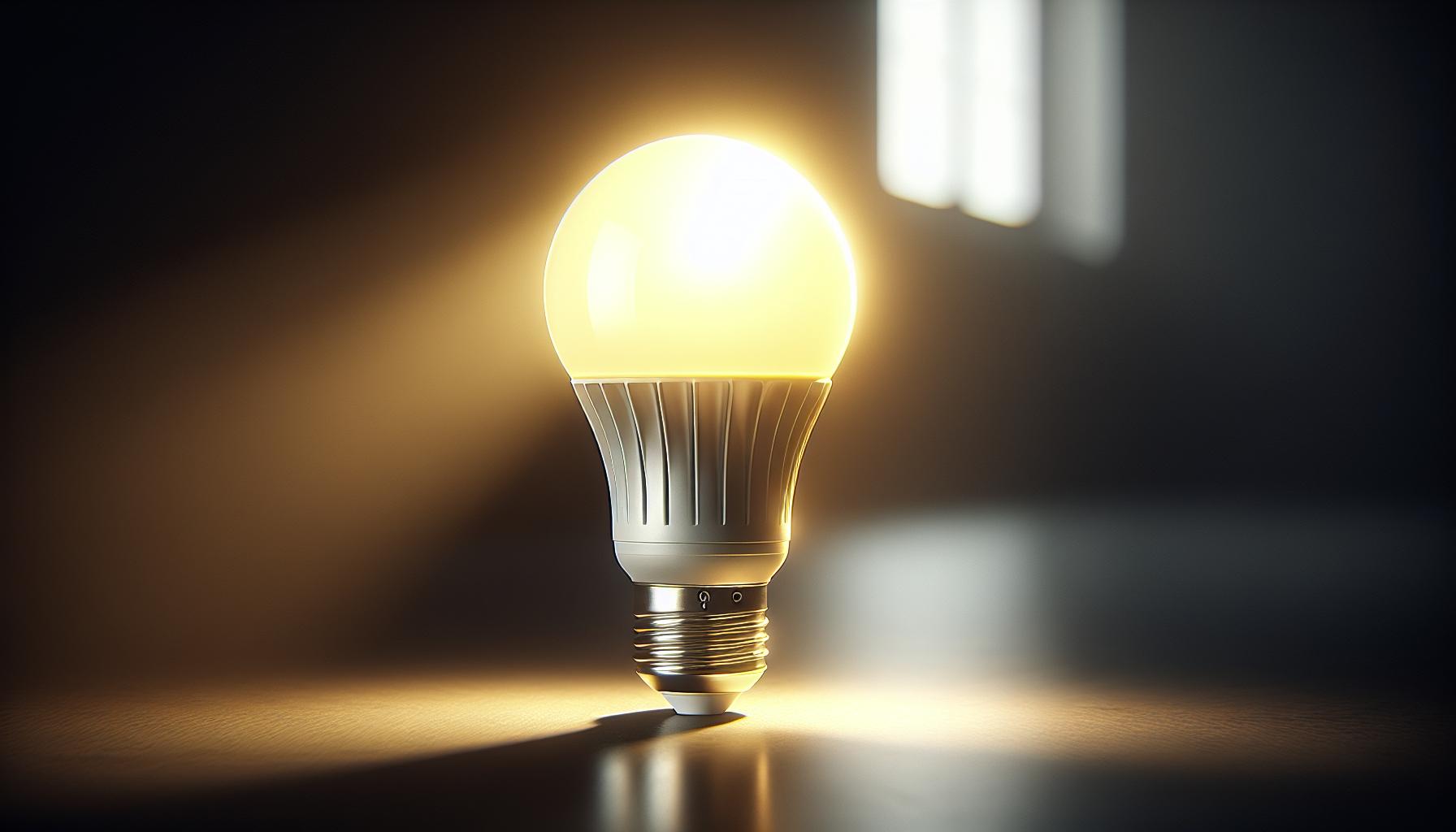Ever wandered down the lighting aisle and noticed how some bulbs cast a warm, yellow glow? You’re spotting the cozy ambiance that yellow light bulbs create. They’re not just any bulbs; they’re your ticket to a comfy, inviting space.
So what bulbs give off that nostalgic yellow light? It’s all about the color temperature and the type of bulb. Whether you’re looking to set the mood or simply love that vintage vibe, understanding your options is key. Let’s dive into the world of yellow light bulbs and find the perfect match for your home.
What Is Yellow Light?
As you delve into the world of lighting, you’ll discover that yellow light has a distinct feel that’s hard to miss. In the spectrum of visible light, it’s the warm glow reminiscent of the sunset or a candle’s flame. Yellow light typically falls within a color temperature range of 2,700 to 3,000 Kelvin. This range is lower on the Kelvin scale, which measures the perceived color of a light source.
This warm light is known for its comforting and relaxing qualities. Yellow light, as opposed to the stark or clinical feel of whiter lights, can help you wind down after a long day. Imagine you’re enveloped in a soft blanket; that’s the coziness yellow light aims to evoke in your living spaces.
When choosing yellow light bulbs, you’re opting for an illumination that promotes relaxation and warmth. These bulbs are fantastic for areas like:
- Bedrooms
- Living rooms
- Dining areas
Let’s not forget about how yellow light can enhance the beauty of your home. It accentuates rich, deep colors and adds a touch of elegance to wood finishes and leather furnishings. And for your DIY projects, it offers a gentle light that’s easy on the eyes—perfect for creating that inviting ambiance you strive for.
It’s also important to be aware that yellow light can influence mood and circadian rhythms. Exposure to warm light, especially in the evenings, can signal your body it’s time to start winding down, preparing you for a good night’s sleep. This is why you might want to avoid cooler, bluer lights in spaces meant for relaxation.
Selecting yellow light bulbs isn’t just about the aesthetics—it’s about tailoring your environment to suit your needs and creating the perfect atmosphere for every moment. Whether it’s a peaceful evening in or a dinner party with friends, the right yellow light can make all the difference. And as a DIY enthusiast and lighting aficionado, you know that the perfect lighting is key to completing the look and feel of any home project.
Understanding Bulb Color Temperature
Grasping the concept of bulb color temperature is crucial when you’re aiming to set the perfect mood in your home. Think of color temperature as the hue of the glow that a light source emits, measured in units called Kelvins (K). The lower the Kelvin number, the warmer and more yellow the light appears. On the contrary, higher Kelvin numbers denote cooler, bluer light.
For yellow light, you’ll be focusing on bulbs ranging from 2,700 to 3,000 K. These bulbs are often labeled as “soft white” or “warm white,” and they’re the go-to if you’re looking to bathe your rooms in a cozy, golden hue akin to the glow of a sunset.
| Color Temperature | Description | Typical Use Case |
|---|---|---|
| 2700K – 3000K | Warm/Soft White | Living rooms, bedrooms |
| 3100K – 4500K | Cool White | Kitchens, offices |
| 4600K – 6500K | Daylight/Blue White | Commercial, garages |
These temperatures influence not just the look but also the feel of your space. Subtle as it may seem, lighting can significantly affect your emotions and energy levels. Warm yellow bulbs are not merely about aesthetics: they’re a strategic choice for areas where relaxation is paramount.
When selecting the ultimate yellow light bulbs, remember that wattage and lumens tell you how much light a bulb can emit, but it’s the Kelvin rating that unveils the color of the light. So scrutinize those packaging labels and wield your knowledge to illuminate your abode with the optimal warmth. Keep in mind, the right bulb can transform a room from simply functional to invitingly harmonious.
Incandescent Bulbs: The Classic Yellow Light
« How Much Does It Cost to Replace Light Bulbs? Uncover the Savings
Is a Light Bulb Transparent? Unveiling the Mysteries Inside »
When you’re seeking that quintessential warm glow, incandescent bulbs are your go-to option. These are the bulbs that might take you down memory lane; they’ve been around since Thomas Edison’s era. Incandescent bulbs provide a rich, golden light typically in the 2,700 Kelvin range, which makes them perfect for creating a cozy and welcoming ambiance in your home.
One of the key reasons for their enduring popularity is their ability to give off a light that’s close to the hue of natural sunset. This isn’t just aesthetically pleasing; the warm tone is known to encourage relaxation and can often be found in living rooms and bedrooms where comfort is a priority.
Here’s what you need to know about incandescent bulbs:
- They operate by heating up a tungsten filament, which glows and emits light when electricity passes through.
- They’re dimmable, allowing you to adjust the brightness to your liking, further enhancing the ambiance.
- The color rendering index (CRI) for incandescent bulbs is typically around 100, which means they illuminate colors in their truest form, without any harshness.
But it’s not just the hue and mood-setting capabilities that give incandescent bulbs their edge. When you’re tackling DIY projects, the familiarity of working with these bulbs can add a layer of ease to your undertaking. Whether you’re restoring a vintage lamp or simply replacing a bulb in a cherished fixture, the simplicity of incandescent bulbs can make the task at hand feel less like a chore.
You’ll also find incandescent bulbs to be cost-effective upfront. Though they might not boast the longevity of newer technologies, they remain a budget-friendly choice for homeowners. And let’s not forget the immediate full brightness these bulbs provide—no need to wait for them to ‘warm up’ as you do with some compact fluorescent lamps.
Bear in mind, though, that incandescent bulbs are less energy-efficient than their LED or fluorescent counterparts. So while they may offer lower initial costs, they could lead to higher electricity bills and more frequent replacements in the long run. Therefore, weigh your options depending on your priorities—be it ambiance, familiarity in handling, cost, or energy efficiency.
Halogen Bulbs: A Modern Take on Yellow Light
When you’re hunting for light bulbs that cast a yellow glow, don’t overlook halogen bulbs. These modern wonders give you a taste of innovation coupled with the traditional yellow hue you love. Halogens boast a consistent output of warm light, typically around 2,800 to 3,200 Kelvin, perfect for those who thrive under the ambience of subdued, cozy lighting.
A major benefit of halogen bulbs is their dimming capability. You can adjust the brightness to suit the vibe you’re aiming for, may it be a calm reading corner or a lively dinner setting. Unlike some energy-efficient bulbs, halogens respond well to dimmers, giving you smooth control without flickering or buzzing.
Here’s a thing that might catch your fancy—if you’re into the finer details, the color rendition of halogen lamps is nearly unparalleled. With a high CRI, typically over 90, they illuminate the true colors of your living space. This means the vibrant hues of your wall art or the soft tones of your throw pillows will look authentic and lively.
Speaking of efficiency, halogen light bulbs are an upgrade from traditional incandescents. They use a gas from the halogen group which helps prolong the lifespan of the filament, making them last longer. It’s a smart choice for someone who doesn’t want to climb up the ladder to swap out bulbs too often.
It’s essential to consider that while they outshine regular incandescent bulbs in terms of efficiency, halogens are still not as energy-saving as LEDs or CFLs. They tend to get quite hot and so aren’t the top pick for energy conservation. It’s about balancing your priorities—if you lean towards exquisite color quality and adjustability, halogen bulbs are your go-to. Let’s not forget their instant-on feature—you’ll get full brightness the moment you flip the switch, no warm-up time required.
As with any home DIY project, it’s smart to understand the ins and outs of the tools you’re working with. Choose halogen bulbs when you’re after that golden-yellow light that makes familiar spaces feel fresh yet intimate.
LED Bulbs: Energy-Efficient and Versatile Yellow Light
When you’re on the hunt for the perfect yellow hue, LED bulbs are your powerhouse choice. These technological marvels are the go-to for those who prioritize energy efficiency without compromising on quality. Let’s shed some light on why LED bulbs are often your best bet.
Unlike their filament-based cousins, LED bulbs work by passing an electrical current through a semiconductor, which illuminates the tiny light-emitting diodes. The result? A brilliant yellow light that’s both energy-saving and long-lasting. You’ll often find LED bulbs come in a range of color temperatures, but for that cozy yellow glow, aim for bulbs marked within the 2,700 to 3,000 Kelvin range.
Here’s a quick comparison:
| Type | Energy Use | Average Lifespan |
|---|---|---|
| Incandescent | High | 1,000 hours |
| Halogen | Moderate | 2,000 hours |
| LED | Low | 25,000+ hours |
One of LED’s biggest draws is its dimmability. Crafting that perfect ambiance for your dinner parties or chill-out sessions becomes a breeze. Fancy a soft, mellow yellow tonight? Just dial down the brightness, and you’re set.
In terms of versatility, LED covers a wide spectrum. Whether you need linear light bars for your kitchen or compact bulbs for accent lighting, LED bulbs fit the bill. And let’s not forget, their color fidelity is exceptional, which means colors appear natural and vivid under their light.
Installation is a DIY enthusiast’s dream. Most LED bulbs are designed to retrofit into existing fixtures, so it’s likely you can upgrade without the need for an electrician. It’s a simple switch that can transform the feel of a room.
As you consider the lighting needs of your space, remember the balance needed between ambiance and energy consumption. With LED technology advancing rapidly, your perfect yellow light is not only within reach – it’s also more efficient and versatile than ever.
Conclusion
You’ve seen how the right yellow light bulb can transform your space into a cozy haven that’s both comforting and stylish. With LED technology, you’re not just choosing warmth and ambiance; you’re also opting for an energy-efficient solution that’s kind to your wallet and the planet. So go ahead and give your home the golden touch it deserves with the perfect yellow light—your evenings will thank you for it.
Frequently Asked Questions
What color temperature range is considered yellow light?
Yellow light typically falls within a color temperature range of 2,700 to 3,000 Kelvin, known for its comforting and warm qualities.
How does yellow light affect mood and circadian rhythms?
Yellow light can influence mood by creating a comforting and relaxing atmosphere. It also plays a role in regulating circadian rhythms, making it ideal for spaces meant for rest and relaxation.
Can yellow light enhance the beauty of my home?
Yes, yellow light can enhance the beauty of your home by accentuating colors, adding elegance to furnishings, and creating a cozy, inviting environment.
Are LED bulbs a good choice for yellow light?
Yes, LED bulbs are energy-efficient and versatile, making them an excellent choice for producing a warm and cozy yellow light. They are also dimmable and have a long lifespan.
Do LED yellow light bulbs work with existing light fixtures?
Most LED yellow light bulbs are designed to retrofit into existing fixtures, making them easy to install and a convenient option for updating your lighting.





